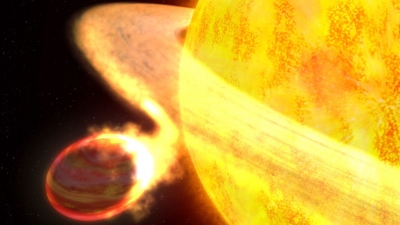
Nothing in the Universe is permanent. One of the most profound rules in all the Universe is that nothing lasts forever. With gravitational, electromagnetic and nuclear forces all acting on matter, practically everything we observe to exist today will face changes in the future. Even the stars, the most enormous collections that transform nuclear fuel in the cosmos, will someday all burn out, including our Sun. In about five billion years, the Sun will exhaust the hydrogen fuel in its core and start burning helium, forcing its transition into a red giant star. A red giant is a dying star in the final stages of stellar evolution. When the Sun turns into a red giant, it will expand and engulf the inner planets- possibly even Earth. After spending about one billion years as a red giant, the star will become a white dwarf, packing most of its initial mass into a sphere roughly the size of Earth. It will eventually become a black dwarf.
In about 5 billion years time the Sun will have exhausted all the hydrogen at its core. The core, which by then will consist of helium nuclei, will then shrink and nuclear reactions will take place in a large shell outside the core, rather than the core itself. The outer regions of the Sun will greatly expand and it will become a red giant.
It is unclear exactly how large the Sun will get when it becomes a red giant. Current estimates are that it will expand to 100-250 times its current diameter (ref 2). If we take the lower value, the innermost planet Mercury (but not Venus and the Earth) will be swallowed up by the Sun. At the higher value, the Earth would also be inside the Sun.
When all of the helium in the core has been converted into carbon, nuclear reactions in the core will once again stop. The Sun will start to convert helium into carbon in a shell outside its core but will become more and more unstable. It will vary widely in brightness as it flares up and ejects some of its outer layers into space and then contracts again. Eventually the whole of the outer regions of the Sun will be blown away forming a glowing shell of plasma called a planetary nebula.
With the lower value, where the Sun expands to 100 times its current radius value, on Earth the Sun would appear 10,000 times larger than it is today. The surface temperature of the Earth would be around 1500 degrees Celsius, hot enough for it glow a dull red colour. The Earth would have lost its atmosphere long before this and will be a bone dry scorched airless desert on which it will be impossible for life to exist.
Credit : Explaining Science
Picture Credit : Google




